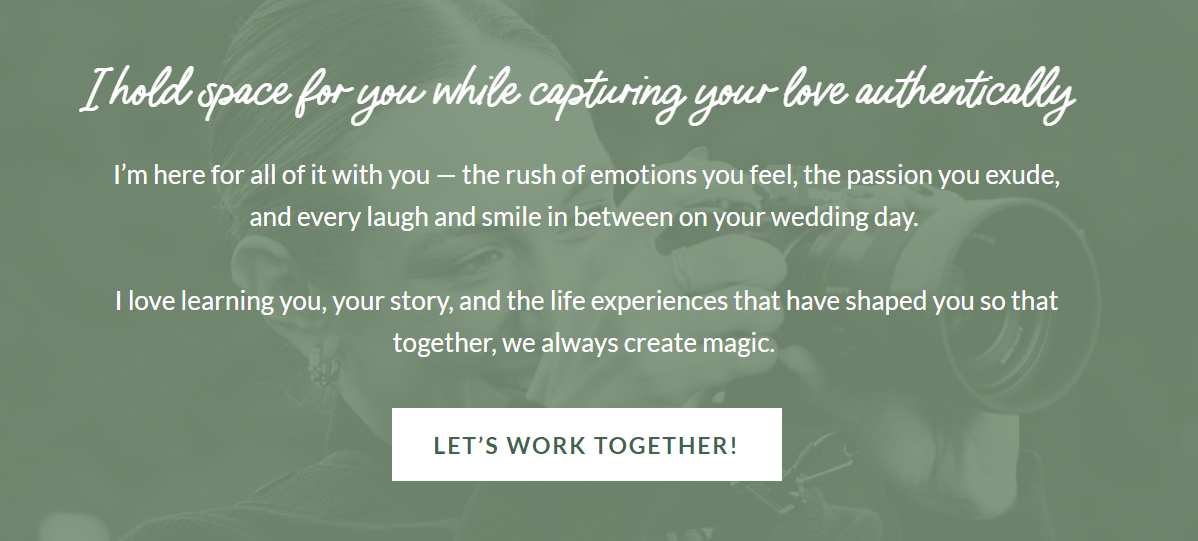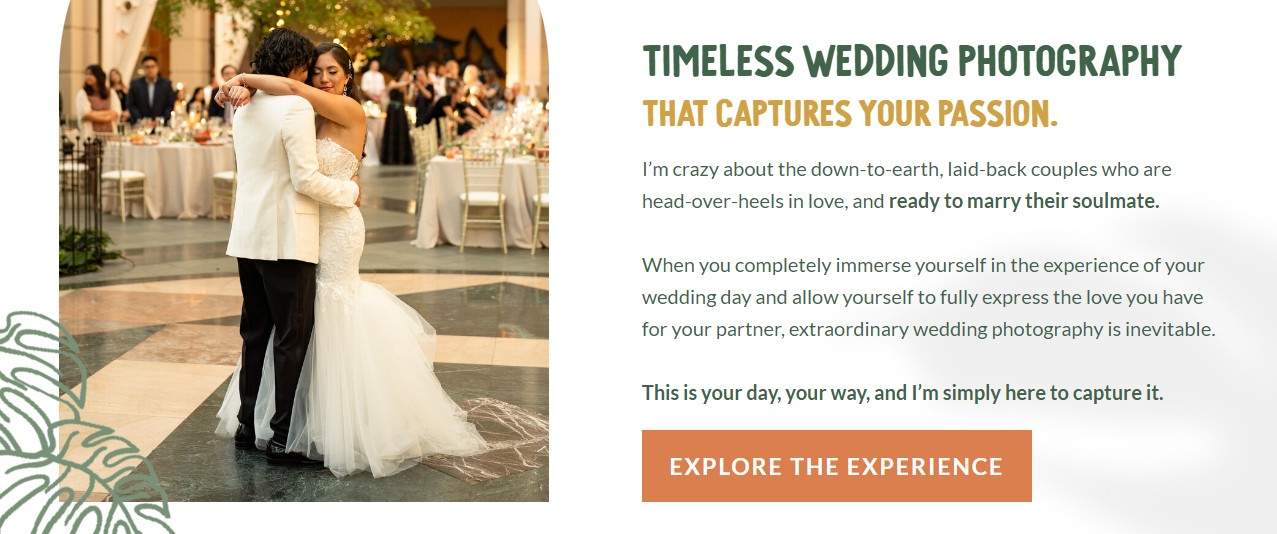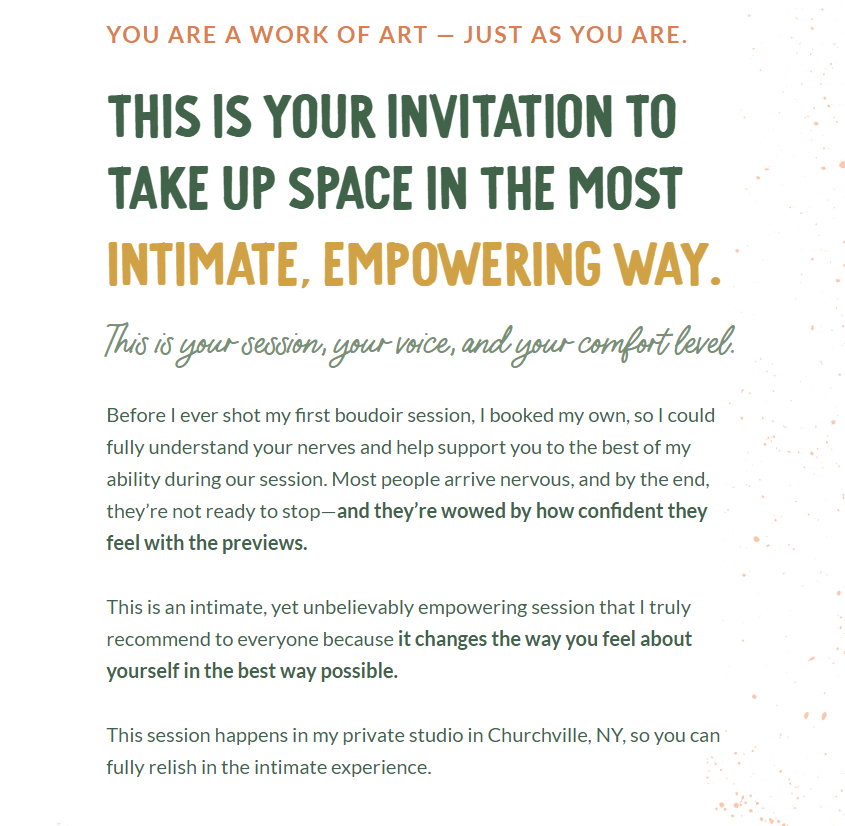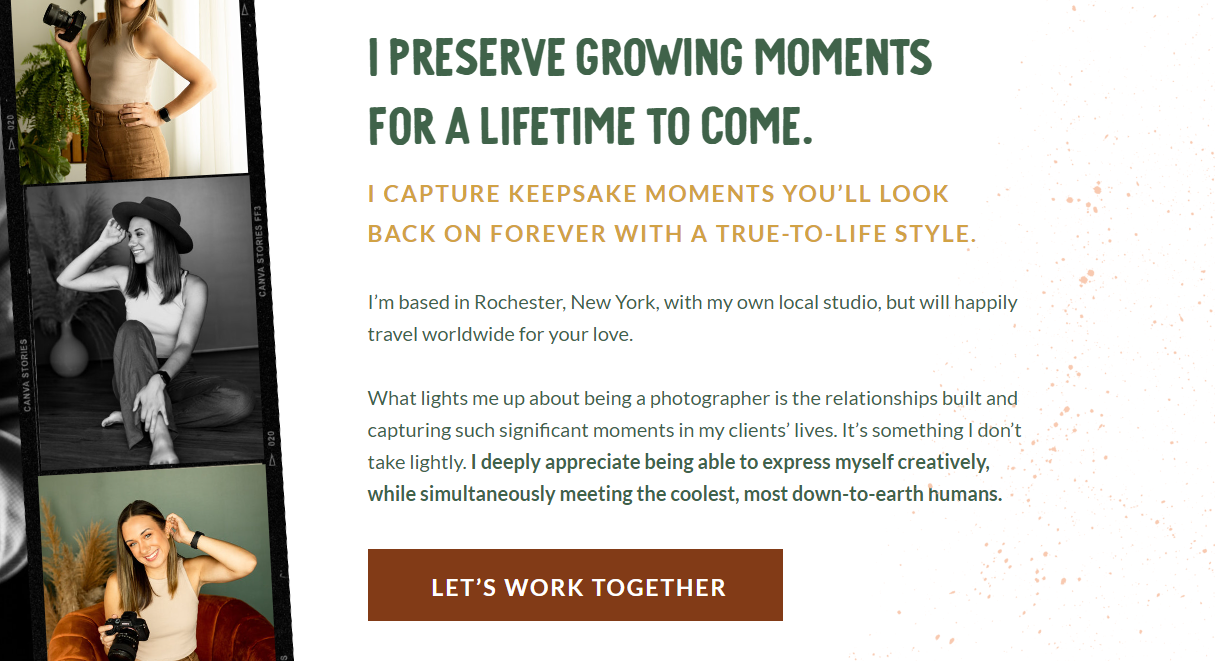12 Expert Website Copywriting Tips to Write Good Copy
Running an online business requires you to wear a lot of hats. We get it! And while the bookkeeping and accounting side of the business makes us cringe, we’ve heard from many clients and other entrepreneurs that nothing is more intimidating than sitting down at your computer staring at a blinking cursor on a blank page when you need to write!
While you certainly don’t need to be an expert copywriter to run a successful business, knowing a few of the more expert tricks of the trade can help you elevate your website copy, no matter what kind of business you run!
Luckily, Becca (founder and lead copywriter here at BDCC) has years of website copywriting experience and has worked on over a hundred websites and sales pages and more (check out the portfolio here), so she knows exactly what makes good conversion copy… and what doesn’t!
Whether you’re hiring out your copywriting or trying to DIY, it’s important to know the essentials of writing expert-level website copy so that when good (or bad) copy lands in your lap, you know whether to use it for your website…or toss it.
To help you out, we want to give you 12 expert website copywriting tips to write good copy and strengthen your messaging. With these tips in your toolbelt, you’ll be able to use your newfound communication skills to write some eye-catching content that attracts readers, builds connections, and leads to more sales!
Are you ready? Let’s do it!
-
Know who you’re writing to (and write to them only!)
You can’t write great copy if you don’t know WHO you’re writing to –and knowing your audience will help you write to your audience. Getting to know your audience inside and out is a key ingredient to being an expert website copywriter! Especially if you want to write website copy and sales pages which are centered around knowing your audience.
Here’s the thing: knowing who you’re writing to requires extensive research. The more information you have about your client (or rather, your client’s client if you’re writing for them), the easier it is to write effective copy that grabs their attention and convinces them to take action.
For example, if you serve a specific group of people, let’s say, women over 40 who want to quit the corporate world to start their own online business, you don’t need to worry about using the latest lingo from Gen Z. You DO need to know how 10-20 years in corporate has ground on their nerves, the effects it’s had on their family life, and the courage it takes to pivot from a long career in that sector.
Always think about who you’re writing for and what’s in it for them. How can your business improve their lives? And how can your copy convey this message in a way they can understand it?
2. Make conversation
Unless you’re writing for a big-name corporate client, you typically want to write like you’re talking to your readers face to face. Imagine having an engaging conversation with someone you’ve just met at a coffee shop or a meet and greet. Write like that!
When you write engaging copy, you have a better opportunity to engage your audience! Engaged copy is an invitation to your reader to keep reading and learn more. If you can naturally sway your readers to stick around through conversational copy, you don’t need to sell as hard because they are probably already very interested in what you have to say AND what you can offer them.
Going off of this point, don’t make the conversation all about you. Make it about your reader. Writing in the first or third person can make a big difference in how your copy reads. When in doubt, just remember your website should always be about your potential client. We recommend that your copy be filled with a lot more “you”s than “I”s.

3. Tell a story
Storytelling is a powerful way to capture the attention of your readers and show that you can relate to their problems. Stories draw people in and engage them (see point above) while building your credibility and authority. As humans, we’re hardwired to love a good story.
Storytelling works best when it appeals to emotion –whether it’s excitement, overwhelm, or even desperation. Emotion draws your reader further into your website because they want to learn more about how they can get more of this emotion OR how they can get rid of it!
All you have to do is give them what they’re looking for. And the best way to do that is by telling a story that’s easy for your reader to see themselves in. Bonus points for telling a story that has a good ending.

4. Sell the benefits
How can you help your audience? Do you create beautiful websites for them? Do you coach women through tough life choices? Explain what your customer or client will get or what they’ll feel, or what they’ll achieve once they work with you.
Always ask yourself:
-
What’s in it for them?
-
How will their life benefit from your offer?
For example, telling your reader exactly what they’ll get inside your digital course is great. Mentioning that they’ll get 6 months of Voxer access to you as a bonus? Amazing! But this is not a benefit. These are features of your offer.
A benefit would be something along the lines of –
Gaining the confidence to start an online business that will unlock the freedom and income they need to support the life they imagine themselves living –whether it’s traveling the world or being more available for their kids.
Tell your readers how your offer can help them (aka the benefits)!

5. Highlight pain points
In a nutshell, your reader has a problem, and they’ve landed on your website to see if you can solve it. They are looking to move from where they are currently to where they want to be. So think about…
What situation has led them to need what you offer?
-
What feelings does this situation bring out in them?
-
Are they worried, concerned, frazzled, stressed, unconfident, exhausted, or something else?
-
What fears do they have that would prevent them from working with you?
These are their pain points. When you understand and address their pain points in your copy, you can remove the roadblocks of your buyers and motivate them to take action by empathetically showing them that you understand what they’re going through and that you have the right solution for them.
6. Have a primary goal for each page
Every single page on your website should have a distinct function. The overall goal for your website copy is to get them to take a BIG action, like book a consultation call, sign up for your newsletter, or buy your products.
Therefore, each page of your website needs to engage your audience and guide them through to the next step, and ultimately, lead them to that BIG action.
A simple example is a home page leading to a service page, which leads to booking a Discovery Call.
You can use Google Analytics to see the current behavior your audience takes to understand how your website’s flow can be optimally adjusted so you can convert website visitors into clients!
7. Don’t underestimate powerful headlines
Here at BDCC, we’re BIG proponents for putting effort into your headlines. Headlines are the first thing your website visitors will read, and if it isn’t good–what makes you think they will continue reading down the page?
Essentially, your headline is the hook that gives your reader a promise and then convinces them to invest their precious time to read the rest of what you have to say. All the content below your headline is the deliverable of the promise your headline just gave.
If you want to learn even more, check out How To Write A Catchy Headline OR check out Copyblogger’s book How To Write Magnetic Headlines in our 10 Best Books For New Copywriters blog post. We’ve also included a headline tip in our 10 copywriting tips for beginners’ blog post!
Headlines are important whether you’re a beginner or an expert copywriter. Here are a few examples of our favorite headlines:


8. Make your copy skimmable
People don’t read word for word. Website visitors skim and scan through copy to find what they’re looking for. So make it easy for them to find exactly what they’re looking for!
Some formatting techniques you can use include using multiple headings and subheadings in different fonts, bulleted lists, numbered lists (like this blog post!), bolding, italicizing, or underlining, varying your sentence and paragraph lengths, and also writing single-line paragraphs.
If you’re writing website copy, always always break up your paragraphs into shorter ones so your potential client scan your copy and find exactly what they need while also encouraging them to stay on your page longer.
This is an easy tip that can be quickly implemented into your writing today!

9. Keep it simple and to the point
We all have a lot to say, but unfortunately, not everyone has the time to listen –or rather, read it.
And people have an extremely short attention span, so keeping your writing simple and to the point is KEY.
One way to do this is by using short sentences and short paragraphs. Cut sentences and paragraphs down to the bare essentials and get your point across as quickly as possible while still making it captivating and compelling. Sounds easy, right?
Honestly, writing long-form copy is much easier than writing copy that’s to the point! Writing website copy that’s concise is an art and a skill that needs to be learned and honed to perfection. There’s a reason why copywriters can charge what they charge! But with practice, you’ll get the hang of it! Promise.
Now, are we saying your blog posts and websites should all be under 100 words? No! Just be conscious of what needs to be said in order for your reader to understand the core of your message.
10. Beware of big words
There is a copy tip circulating the internist that says you should use short and simple words rather than longer, more articulate alternatives. And while we mostly agree with that –we have a few caveats. You DO want to write your copy at the 4th-grade level, and you also want to avoid using jargon words your ideal client won’t understand.
But in terms of throwing out words just because they’re big or not as well used, we would say that it depends on your brand.
Sometimes the bigger words can be the more impactful words (not always, but sometimes) and reflect the vibe you’re trying to go for! As long as your reader doesn’t need a dictionary to interpret what you’re trying to say, you should be able to use the words that are most aligned with your brand.

11. Split-test your copy
Here at BDCC, we love split testing! It’s one of the best ways to understand how effective your website copy is and why. Because here’s the thing: you can write the best website copy out there, but if it doesn’t convert, it’s not good copy (just good writing!).
Dan Gower said it first, “Good copywriting is as much a science as it is an art.” Test anything and everything whenever you can. Split-test headlines, subheadlines, device-level testing, and more. Eventually, you’ll have proof of what works and what doesn’t work with your audience.
12. Use stats!
Back up what you say with statistics, research data, case studies, testimonials and any other credible source that proves what you’re saying is true. And when you link to resources, please make sure they are reputable sources! Linking to a Buzzfeed article isn’t enough. If that article talks about a study…Find. That. Study…and link to THAT article or journal.
Hopefully, these 12 expert website copywriting tips will help you improve the effectiveness of your website copy (or your client’s), one word at a time! And don’t stop at these 12 tips. There is so much you can learn about copywriting!
If you learn best from books, check out this post, if you learn best from podcasts, check out this post –both are filled with great resources to up your copy game!
If you need some extra resources from BDCC to help you start writing today, our shop is FULL of incredibly useful templates and copy bundles to help you write every type of website copy you can think of to grow and scale a successful business –whether you’re a professional copywriter or a DIYer!
Shop our templates, outlines, questionnaires, and everything else you need to write your copy today!
Don’t forget that you can always hire out your copywriting if writing just isn’t your jam. We LOVE writing all kinds of copy for our clients, including sales page copy, landing page copy, email funnel copy, and of course, our specialty, website copy.
Contact us today to see how we can help your business grow with connective and compelling words that speak directly to your ideal clients!